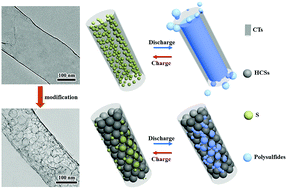A spheres-in-tube carbonaceous nanostructure for high-capacity and high-rate lithium–sulfur batteries†
Abstract
The uses of sulfur, which has a high theoretical specific capacity of 1675 mA h g−1, as a commercial cathode for lithium batteries have been substantially hindered by the insulating nature of sulfur and the dissolution of intermediate polysulfides (Li2Sx, 4 < x ≤ 8) into the electrolyte. In this work, a spheres-in-tube carbonaceous nanoarchitecture has been successfully engineered as an effective sulfur host, by encapsulating heteroatom-doped hollow carbon spheres into an intact carbonaceous nanotube (I-HCSs@CT). The structural features including hierarchical porosity and the intact nature of the CT wall and HCS framework have cooperatively endowed I-HCSs@CT with outstanding capability of host loading, good electrical conductivity, a high utilization rate and excellent stability of sulfur. As a result, our sulfur/carbon composites deliver a large discharge capacity of 1426 mA h g−1 at 0.1C with a high sulfur loading of 72.1 wt%. The obtained electrode demonstrates superior high-rate cycling performance, with a high specific capacity of 746 mA h g−1 at 0.5C being retained after 500 cycles.



 Please wait while we load your content...
Please wait while we load your content...